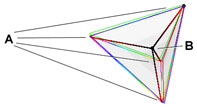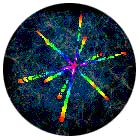|
|
 |
 |
 |
 |
 |
|
 |
|
|
|
|
|
|
|
SCIET Awareness
Equidistance
Change occurs equally in all directions
The Stages of Creation
SCIET Awareness
|
|
Equidistance defines the basis for the location of interactive points within a SCIET An example of this is the tetrahedral structure of the SCIET Tetron, which is composed of four external points and a single internal point. Four equidistant points (A) are complemented and balanced by a fifth one (B) at the center, which is equidistant to them.
Equidistance Related ideas:
Because the fifth point (B) is created by the prior existence of another point, it represents the concept of a generational level.
Created by a point-to-point relationship involving a single angularity, the two other angles of the tetron are descended resonance values, that is to say they are subdivisions of the primary angularity.

The center value, the fifth point (B), is compounded from the four angularity point values. It is a much greater subdivision in order to accommodate the other four (A). It is this quality of greater subdivision that is the key to understanding the SCIET concept of ``positive" and ``negative' polarity. The receptive or negative polarity is able to accommodate more change because it has more capacity to harmonize. In this way positive and negative are relative.
The fifth point (B) is the most receptive level.
|
|
|
|
Please contact our Webmaster with questions or comments
Copyright 1995-2013© Dane Michael Arr |
|
|
|
|





